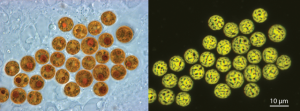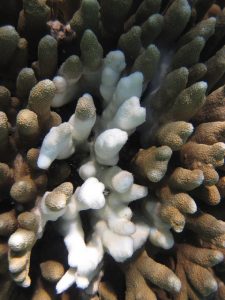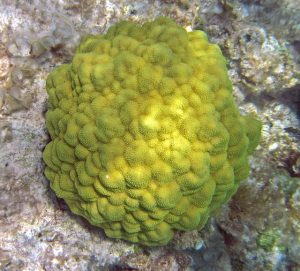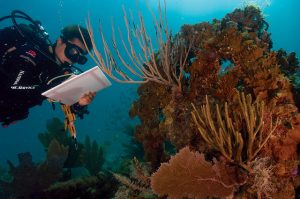Riding along with the current across the pristine clear waters, it was like being in a giant swimming pool, only infinitely more exciting. This was our last dive before completing our Open Water SCUBA Diving certificate, and definitely the most exciting. I’d fallen in love with the underwater world 12 years prior while snorkeling over the reef off the coast of Cozumel, Mexico. Now, back in the same waters, I was completely mesmerized by the multitude of colorful fishes, giant sea fans, eels and crustaceans, and just sheer life exploding all around us. It’s not for nothing that coral reefs are often referred to as the rainforests of the sea. In fact, it is estimated that coral reefs house at least 25% of all marine species.
But what are corals, anyway?
Contrary to what many people believe, corals are neither rocks nor plants. They are actually tiny organisms that belong to the phylum Cnidaria, which also includes anemones and jellyfish. The basic structure of the coral is the coral polyp.

It is a tube-like structure with an opening on one end, which is surrounded by tentacles with which the polyp can catch floating food particles. All corals have soft bodies, but some— the hard or stony corals— produce a calcium carbonate skeleton which is the building block of coral reefs. Coral larvae are released into the water, and eventually settle upon a surface. Then, they begin to deposit calcium carbonate to protect their bodies. Little by little, the polyps multiply and form a colony with a shared skeleton. Many colonies together form a coral reef. A little-known fact is that stony corals produce growth rings in their skeletons, similar to trees, from which information can be obtained regarding the age of the reef and the types of corals present in it.
Coral Symbionts

Corals are most commonly found on shallow tropical waters which are low in nutrients. They have adapted to thrive in these low-nutrient waters by associating with tiny, algae-like dinoflagellate protozoans known as zooxanthellae. In this symbiotic relationship, the zooxanthellae provide the coral with energy through photosynthesis, and in return receive carbon dioxide, nutrients and a position with access to sunshine. Even though coral polyps have an oral disk to catch food particles with, they derive most of their energy from their symbionts.
Recently, scientists have discovered that this relationship dates at least as far back as the Triassic era. Frankowiak and colleagues compared the characteristics of coral fossils to samples of modern-day symbiotic and asymbiotic corals (1). They focused on certain differences apparent between corals with symbionts and those without. For example, skeletal growth bands are highly regular in symbiotic corals, but are discontinuous and irregular in the asymbiotic. Symbiotic corals also have a higher nitrogen isotope composition. The researchers found that the characteristics of the fossils closely matched those of modern-day symbiotic corals. Moreover, since the habitat of the corals in the Triassic era was also low in nutrients, photosymbiosis was probably the reason why the expansion of stony corals during that era was possible.
As Daniel Sigman, Dusenbury Professor of Geological and Geophysical Sciences of Princeton University Daniel Sigman, stated on a press release last month, “It is important to know how far back in time symbiosis evolved because it gives insight into how important symbiosis is to the health of coral reefs.” He added “It appears that the origin of symbiosis corresponds to the rise of coral reefs in general.”
What is coral bleaching?

Being sessile—or immobile— organisms, corals are very sensitive to changes in water parameters, such as turbidity and temperature. When corals are stressed, especially by an increase in water temperature, they expel their zooxanthellae. Although coral polyps can ingest some food through their oral disks, their symbionts provide them with around 90% of their energy needs. Once a coral expels its symbionts it begins to starve and die. The term bleaching comes from the white appearance of the coral once the symbionts are expelled, since it is the pigments of the zooxanthellae what gives corals their characteristic brownish color.
Coral reefs provide many benefits for fisheries, tourism, and for shore protection. Estimates of their annual global economic value range from $30 billion up to $172 billion US dollars. Given the changes in water conditions regarding increases in pollution, turbidity and temperature, stemming from direct human activity and climate change, there is a real reason for concern about the future of our coral reefs. Nonetheless, recent studies have reported surprising results regarding the coping mechanisms of corals and how resilient they can be.

Researchers Kenkel and Matz, from the University of Texas, studied the differences in gene expression in corals of the species Porites astreoides from inshore and offshore reefs off the coast of the Lower Florida Keys (2). They had previously observed that inshore coral colonies, which are exposed to greater environmental variations, exhibit a higher thermal tolerance than the offshore corals. For this study, they took fragments from 15 colonies of inshore and offshore reefs and transplanted them to both native and foreign sites. One year later, they measured and compared the gene expression profile of the transplanted corals.
They found that native inshore corals transplanted offshore had a greater capacity to change their gene expression—or a greater genotypic plasticity—compared to native offshore corals transplanted inshore. Also, inshore corals had upregulated environmental stress response genes, and although bleaching was observed in the inshore site, it was only on the corals that had been transplanted from offshore.
The surprising thing about this study is that the resistance to high temperatures resulted from a greater genotypic plasticity in the inshore corals. The authors conclude: “…inshore corals from a more variable thermal environment developed an ability to more dynamically regulate expression of environmental stress response genes, which is associated with maintenance of symbiont densities following thermal stress.”
Additionally, it is possible that some of the stressors affecting corals might act antagonistically to each other, resulting in a lower total damage than if they were present by themselves. An interesting case study are the reefs off the coast of Singapore. These corals have been subject to important disturbances, including rises in turbidity and temperature, and eutrophication. It has been estimated that underwater visibility decreased from 10 meters in the 1960s to around 2 meters in the 1980s, and has remained at that level ever since. Furthermore, the reefs in Singapore experienced two thermal bleaching events, one in 1998 due to El Niño, and one in 2010.
Guest and colleagues reported earlier this year on their 27-year long observations of the effects of chronic and acute disturbances on shallow and deep coral reefs off Singapore (3). Surprisingly, they found that despite facing important disturbances, coral cover off the shallow reefs of Singapore is currently above the average for the reefs in the Indo-Pacific.

SCUBA divers carried out surveys of the coral and benthic communities of coral reefs at 15 different sites, located at two depths: 3-4 meters (“shallow” sites), and 6-7 meters (“deep” sites). They found that coral cover at the shallow sites decreased continuously up until 1998, but by 2008 it had returned to around 1993 levels. In contrast, coral cover at the deeper sites decreased markedly until 2003, and has remained relatively stable with no signs of recovery. This lack of recovery is probably due to the turbidity, which could limit the available light so that at depths below 4 meters, the corals could not rely on the photosynthesis of their symbionts to meet their energy needs. Also, the deposition of fine sediments could create a less stable strata which could make it difficult for coral larvae to attach and survive.
One effect of environmental changes and declining coral health that has been observed in many reefs is a shift from coral domination to macroalgae domination. This shift is detrimental because macroalgae don’t provide the benefits that corals do, such as reef structure and housing. Interestingly, the research team observed no evidence of such a shift in any of the Singaporean reefs. In fact, macroalgae coverage only slightly increased during the study period, despite low numbers of herbivore fish.
These findings suggest that, at least in some cases, environmental disturbances might obstruct the negative effects of each other. For example, on the shallow reefs, the high turbidity of the water may be limiting the photosynthesizing ability of the algae, thus impeding their expansion. The turbidity could also be protecting the corals from bleaching by shielding them from irradiance. In their concluding remarks, the authors note: “Our data support the notion that coral reefs will change rather than disappear entirely due to coastal land use changes and provide a glimmer of hope that some heavily disturbed Indo-Pacific reefs can remain in a coral dominated state.”
Certainly, results like these give us some hope for the future of coral reefs. As Dr. James Guest, the first author of the study, expressed, “This is by no means a cause for complacency regarding the state of our reefs, but rather highlights that if we can reduce local stressors, reefs are more likely to be able to rebound from the effects of global stressors such as climate change.”
References:
(1) Frankowiak, K., Wang, X.T., Sigman D. M., Gothmann A.M., Kitahara, M.V., Mazur, M., Meibom, A., Stolarski, J. 2016. Photosymbiosis and the expansion of shallow-water corals. Science Advances, 2(11),e1601122.
(2) Kenkel, C.D., Matz, M.V. 2016. Gene expression plasticity as a mechanism of coral adaptation to a variable environment. Nature Ecology and Evolution, 1(0014).
(3) Guest, J.R., Tun, K., Low, J., Vergés, A., Marzinelli, E.M., Campbell, A.H., Bauman, A.G., Feary, D.A., Chou, L.M., Steinberg, P.D. 27 years of benthic and coral community dynamics on turbid, highly urbanised reefs off Singapore. Scientific Reports, 6(36260).
If you’d like to read about corals in more detail, be sure to check:
Corals and Coral Reefs by The Ocean Portal Team of the Smithsonian Museum of Natural History.